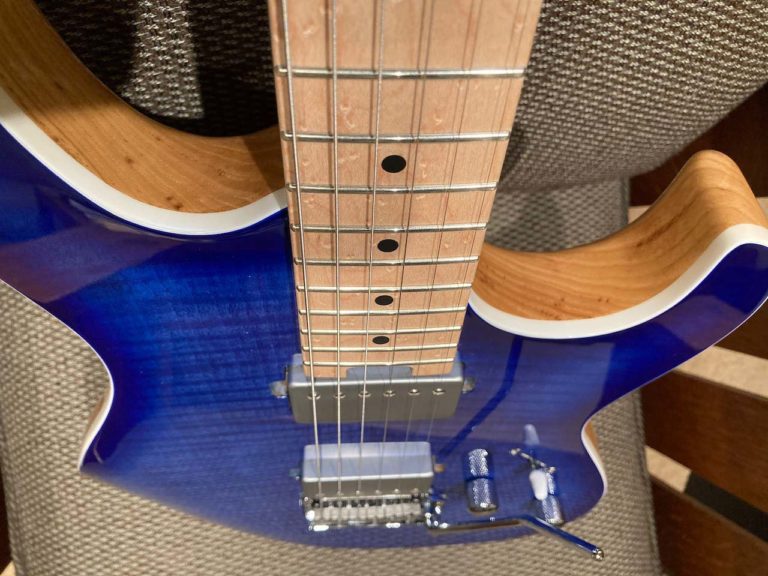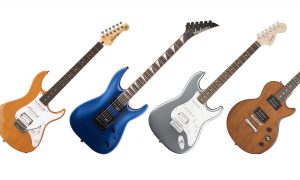Guitar River is reader-supported. We may earn a commission when you make a purchase using the links on our site.
Learn more.
Cort G290 FAT Review: Best Bang for the Buck

The Cort G290 FAT is an excellent value. You should be able to buy a new one for around $600 or so. It will depend on where you live, shipping costs, and what deals Reverb sellers are offering.
I was able to get an amazing deal on a new one, though I had to wait three months as it was part of a preorder. At the time of this review, there are several Reverb preorder listings at $599. (Pro tip: watch the item, and you might get an offer.)
Cort describes the G290 FAT as a session-style guitar with a boutique design, and a reasonable price tag. The model is aimed at players looking for versatility, and the ability to cover a wide range of tones.
Comparisons
When evaluating styling and features, some guitars that come to mind are much more expensive and custom guitars from Suhr, Charvel, Music Man, and Ibanez.
Those guitars are thousands of dollars more expensive, and it’s not quite a fair comparison. But it seems Cort is going after the boutique Superstrat vibe with the G290 FAT.
With those name brands, you’ll find name brand components, US and Japanese manufacturing, and prices to match. Cort manufactures the G290 FAT at its factory in Indonesia, and the hardware is Cort-branded.
A more apt comparison might be the PRS SE Standard 24. While the specs are a little different, it’s made in the same factory and the quality should be comparable. Another guitar closer in specs and price is the Sterling by Music Man Luke, also made in Indonesia.
If you are after high-end styling and features without breaking the bank, the Cort is definitely worth a look. Trying it out in person may be tough as you’ll likely need to buy it online.
Design
The first thing you will notice is the design. The body itself is a standard S-type body with a bit of an offset. The updated shape gives it a dynamic and unique look, setting it apart from the typical Superstrat.
The clear finish on the two-piece swamp ash body shows off some beautiful wood grain on the back and sides of the body. The body is topped with a flamed maple veneer, with two finish options–antique violin burst, and bright blue burst. I went with the blue.
Thick binding around the body nicely complements the flamed maple veneer and swamp ash body. The neck and fretboard are both birdseye maple. The wood grain adds some visual interest and character. And the chrome hardware completes the premium look.










Features
Since Cort is making their own in-house brand, they’ve packed it full of features that you won’t find on larger brand names in this price category.
Neck and Fretboard
Aside from the beautiful tonewoods used, The fretboard is a compound radius, moving from 12” to about 16”. The truss rod is a spoke nut system, easily accessible at the base of the neck. This makes truss rod adjustments easier and more precise.
The neck is somewhere between a thin shredder neck and a fatter S-style vintage neck. It’s thinner than a Fender Standard Strat, but not nearly as thin as an Ibanez. Cort calls it an Ergo-V profile. The rounded heel joint makes playing the higher frets a breeze.
Bridge and Tuners
The tuners are Cort-branded staggered and locking tuners. The staggered tuners eliminate the need for string trees, keeping the headstock nice and clean. The locking mechanism is an easy to use thumbwheel on the backside of the tuner.
The bridge is a two-point floating system with a drop-in tremolo arm. There is no need to thread the arm into the tremolo, it’s held in with a grub screw. The bridge saddles, tremolo block, and baseplate are all steel.
Controls
The controls are simple and straightforward with one volume, one tone, and a 5-way pickup selector switch. Positions 1, 3, and 5 activate the bridge, neck, and both combined as you would expect.
Positions 2 and 4 use either both outer coils or both inner coils depending on the position. Position 2, closest to the bridge, activates both outer coils, while position 4 activates both inner coils.
Pickups
The pickups are Cort’s VTH-77 pickups. The “VTH” stands for “Voiced Tone Humbucker.” Cort describes them as having a higher output, with good clean, classic rock, and bluesy tones as well. The specs note Alnico V bar magnets.
The tone profile chart on Cort’s description page is accurate. The pickups seem a bit more biased toward midrange and treble. They have an excellent clean tone, and sound great with some drive and distortion.
Last but not least, the output jack is flush-mounted on the side, and has a high-quality feel to it. The jack provides a solid connection, and I don’t foresee any issues with it.
Tone
The sound of the guitar is excellent. I mostly play using clean tones, or a bit of crunch. The rhythm and lead positions are both very capable. The bridge pickup has some extra treble bite that you would expect, and the neck pickup emphasizes more bass and mid-tones.
The tone is well-balanced and clear. There is some brightness, perhaps amplified by the maple neck and fretboard and the swamp ash body. Note sustain is excellent, as is individual note articulation. Positions 2 and 4 give you access to very usable single-coil sounds. Position 2 especially has a nice Strat or Tele-style twang.
The guitar is capable of producing a variety of tones for different genres, and would be well-suited to both recording and performance.
Minor Issues
I only have a few minor complaints. The guitar is heavy, weighing about 9 pounds. It’s heavier than any other Strat-style guitar I own. I can see the weight being an issue for some, especially when standing or performing. Sitting down, it’s not bad, but I wouldn’t want to sling it around my shoulder for an extended period.
The nut seems to be a plastic nut, though there were no specs listed on the Cort website. I would have liked a higher-end nut. Some other guitars in the same price range have upgraded nuts, such as the Yamaha Pacifica 600 Series with a Graph Tech nut. Something like that would compliment the excellent bridge and locking tuners.
And the nut on my guitar was installed slightly off-center. It’s cut properly in relation to the fretboard, but it’s just not centered. That’s the only finishing flaw I found. It’s not a huge deal, but I would have hoped for it to be installed properly at this price point.
The guitar arrived with the bridge plate pushed down on the bridge posts. The tension on the strings was holding it all together, but I had to move it back to the correct pivot points. Thankfully, there doesn’t seem to be any damage.
Positions 2 and 4 sound good, but you will need to even out the volume when switching between the full humbucker and the single coil positions. Positions 1, 3, and 5 are a bit louder. I found it easiest to roll the volume back slightly for the humbuckers, and use full volume with the single coils.
I’m still learning the tonal possibilities of this guitar, but I tend to prefer the humbuckers in the neck, middle, and bridge positions. The split positions sound great, but not quite the same as a dedicated single coil. I’m used to playing Strat-style guitars with single coils, so your mileage may vary.
Final Thoughts
Overall, I think this is an excellent guitar for the cost. If you are not concerned about brand names, this is a very good value. You’ll have something equivalent to the PRS SE series, Sterling by Music Man, or the Yamaha Pacifica 600 series.
Check out the full specs at Cort’s website.
Here are the latest Cort G290 FAT listings at Reverb.
Update: For 2022, Cort has added the G290 FAT II. This updates the model with some extra features including a Graph Tech TUSQ nut, roasted maple neck, and Luminlay side dots.


